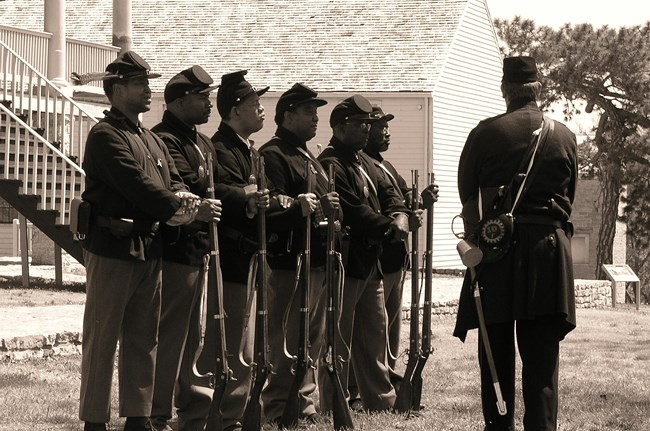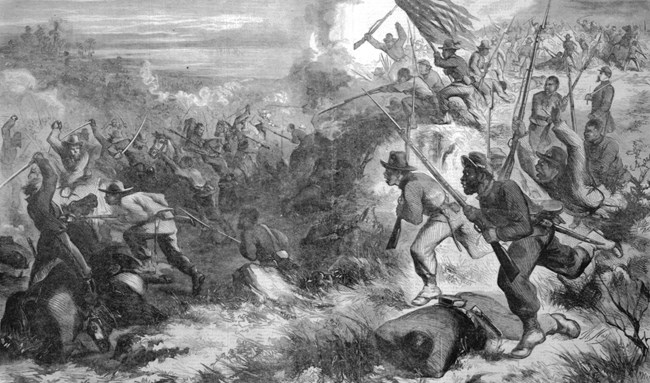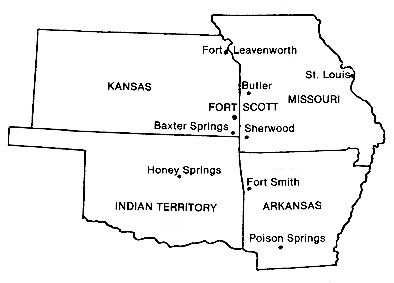
Kansas State Historical Society "Now is Our Time to Strike" During the celebration of the Emancipation Proclamation on January 1, 1863 at Fort Scott, Kansas, Captain William D. Mathews, commanding Company D of 1st Kansas Colored Volunteer Infantry Regiment, gave a speech highlighting the opportunity for Blacks to fight in the Civil War (1861-1865). He declared: "Today is a day that I always thought would come …Now is our time to strike. Our own exertions and our own muscle must make us men. If we fight we shall be respected. I see that a well-licked man respects the one who thrashes him." The regiment's commanding officer – Colonel James M. Williams – also spoke, insisting that "this will be no mere struggle for conquest, but a struggle for their own freedom, a determined and, as I believe, irresistible struggle for the disenthralment of a people who have long suffered oppression and wrong at the hands of our enemies." Kansas was the first Northern state to recruit, train, and send Black soldiers into combat during the Civil War. Fort Scott served as the home base for both the 1st and 2nd Kansas Colored Infantry, with both regiments being mustered into federal service on Fort Scott's former parade ground. The Emancipation Proclamation officially authorized the recruitment of African American soldiers for federal service (although the 1st Kansas Colored had earlier been recruited as a state unit in August 1862). This meant it was now legal for free Blacks and former slaves to fight back against the institution of slavery and seek to abolish it through armed resistance. As virtually every Southern slave code prohibited Blacks from carrying guns, the proclamation had a profound psychological impact across the region.

NPS Photo Kansas the Land of Freedom Before the Civil War, enslaved people sought freedom through self-liberation or slave revolts. During the Civil War, they were often assisted by Jayhawkers, Free-Staters and abolitionists from Kansas who destroyed pro-slavery resources in Missouri. Jayhawkers often emancipated slaves as contrabands of war and brought them back to Kansas. Enslaved people across the region escaped to Kansas seeking freedom because slavery was prohibited in the state. Having self-liberated or otherwise found freedom, Black Americans joined the Union Army hoping to free family members still enslaved. Recruitment of Black Troops When war erupted, President Abraham Lincoln rejected the idea of using African Americans in combat. He believed the Border States, where slavery existed, would secede from the Union. Many whites in the North and South feared an indiscriminate armed insurrection against whites. However, Kansas Senator –James Lane –promoted the idea of using fugitive slaves in combat asserting "...that the effect of marching an army on the soil of any slave State will be to instill into the slaves a determined purpose to free themselves; and…will crush out everything that stands in the way of acquiring that freedom." 'Lane envisioned that 'there would be a colored army marching out of the slave States while the army of freedom was marching in." In August 1862, Lane began recruiting free Blacks and former slaves into the 1st Kansas Colored Volunteer Infantry Regiment. The 1st Kansas Colored was first organized as a state unit, not a federal unit. While the Militia Act passed by Congress in July 1862 authorized the recruitment of Black soldiers, President Lincoln chose not to do so for political reasons.

The 1st Kansas Colored Infantry first saw combat at the Battle of Island Mound in Missouri on October 29, 1862. In this skirmish, roughly 225 Black troops drove off 500 Confederate guerillas. Senator Lane used the victory as proof that Blacks could fight with intelligence and bravery. Richard Hinton –the 1st Kansas Colored Infantry adjutant –had this to say on the 1st Kansas Colored's victory at Island Mound, he proclaimed, "The men fought like tigers, each and every one of them, and the main difficulty was to hold them all well in hand." When the Emancipation Proclamation was issued, the Confederate States ignored it. Additionally, enslaved people in the loyal Border States and in Union occupied Southern territory were not included. However, the Emancipation Proclamation authorized the enlistment of free Blacks and former slaves as soldiers in the Union Army. On January 13, 1863, the 1st Kansas Colored was mustered into federal service on the former parade ground at Fort Scott. On December 18, 1864, the 1st Kansas Colored was later reorganized as the 79th United States Colored Troops (USCT), and the 2nd Kansas Colored was organized as the 83rd USCT. Although Black soldiers were enlisted in the Union Army, discrimination persisted. Black troops were paid less than their white counterparts as Black soldiers were paid $10 per month while white soldiers were paid $13 per month. The War Department refused to commission Black officers until late in the war. Notably, about 125 African Americans did gain commissions, including William D. Mathews, who served as a lieutenant in an independent Black artillery unit. Also, if captured by Confederate soldiers, Black soldiers were executed on the field of battle or taken back into slavery. 
Battle History of the 1st Kansas Colored Volunteer Infantry Regiment
Freedom was their Cause African Americans served in the Union Army for many reasons, and it is clear that the efforts of more than 180,000 Black soldiers directly contributed to Union victory. Slavery was finally abolished and African Americans were granted citizenship through Constitutional amendments. While prejudices remained, preventing many from enjoying the fruits of newfound freedom, the soldiers of the 1st and 2nd Kansas Colored Infantry Regiments, indeed all who served in the United States Colored Troops, had begun the long march toward civil rights for all people, a noble goal that continues to this day. 
Sources
Related Sites
|
Last updated: June 9, 2022

